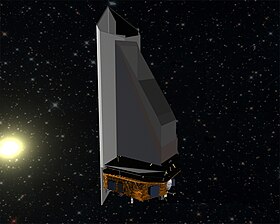Near Earth Object Camera
 |
|
| Mission type | Astronomy |
|---|---|
| Operator | NASA / JPL |
| Website | neocam |
| Mission duration | Planned: 4 years |
| Start of mission | |
| Launch date | Proposed: 2021 |
| Orbital parameters | |
| Reference system | Heliocentric |
| Regime | Sun–Earth L1 |
| Main telescope | |
| Diameter | 50 cm (20 in) |
| Wavelengths | Near-infrared (6–10 µm) |
The Near-Earth Object Camera (NEOCam) is a proposed space-based infrared telescope designed to survey the Solar System for potentially hazardous asteroids. NEOCam would survey from the Sun–Earth L1 Lagrange point, allowing it to look close to the Sun and see objects inside Earth's orbit. NEOCam would be the successor of the NEOWISE mission; the principal investigator is NEOWISE's principal investigator, Amy Mainzer of NASA's Jet Propulsion Laboratory.
Proposals for NEOCam were submitted in 2006, 2010, and 2015 to the NASA Discovery Program. In 2010, NEOCam was selected to receive technology development funding to design and test new detectors optimized for asteroid and comet detection and discovery. On 30 September 2015, the Discovery Program advanced NEOCam along with other four candidate missions for refinement during the next year, with each mission receiving US$3 million for a one-year study. Although it was not successful in the 4 January 2017 selection of the next two Discovery missions, it was given an additional year of funding.
The primary scientific goal of NEOCam is to discover and characterize the orbit of most of the potentially hazardous asteroids larger than 140 metres (460 ft) over the course of its four-year mission. NEOCam's field of view would be large enough to allow the mission to discover tens of thousands of new NEOs with sizes as small as 30 m (98 ft) in diameter. Secondary science goals include detection and characterization of approximately one million asteroids in the asteroid belt and thousands of comets.
In 2016, the NEOCam team proposed to launch in 2021 and find two-thirds of missing objects in the larger-than-140-meters category within four years.
The scientific payload would consist of an infrared telescope and a wide-field camera operating at two thermal infrared wavelengths. The mission would likely use a special mercury–cadmium–telluride detector called HgCdTe Astronomical Wide Area Infrared Imager (HAWAII) in development by Teledyne. This detector has good infrared performance without the use of a cryogenic fluid refrigeration. NEOcam will keep relatively cool by operating at the Sun–Earth L1 point and employing a Sun shield. The prototype sensor was successfully tested in April 2013.
...
Wikipedia
